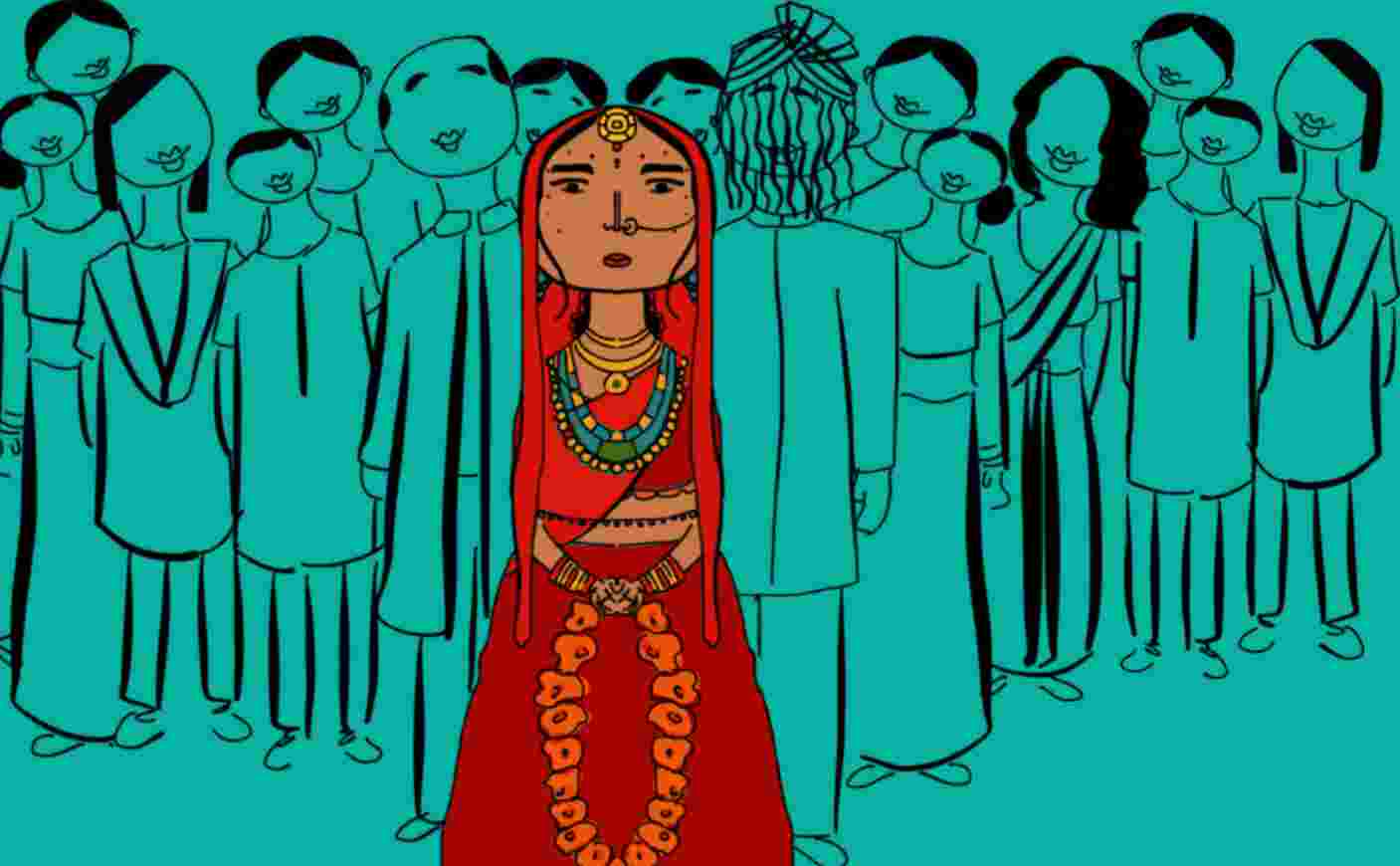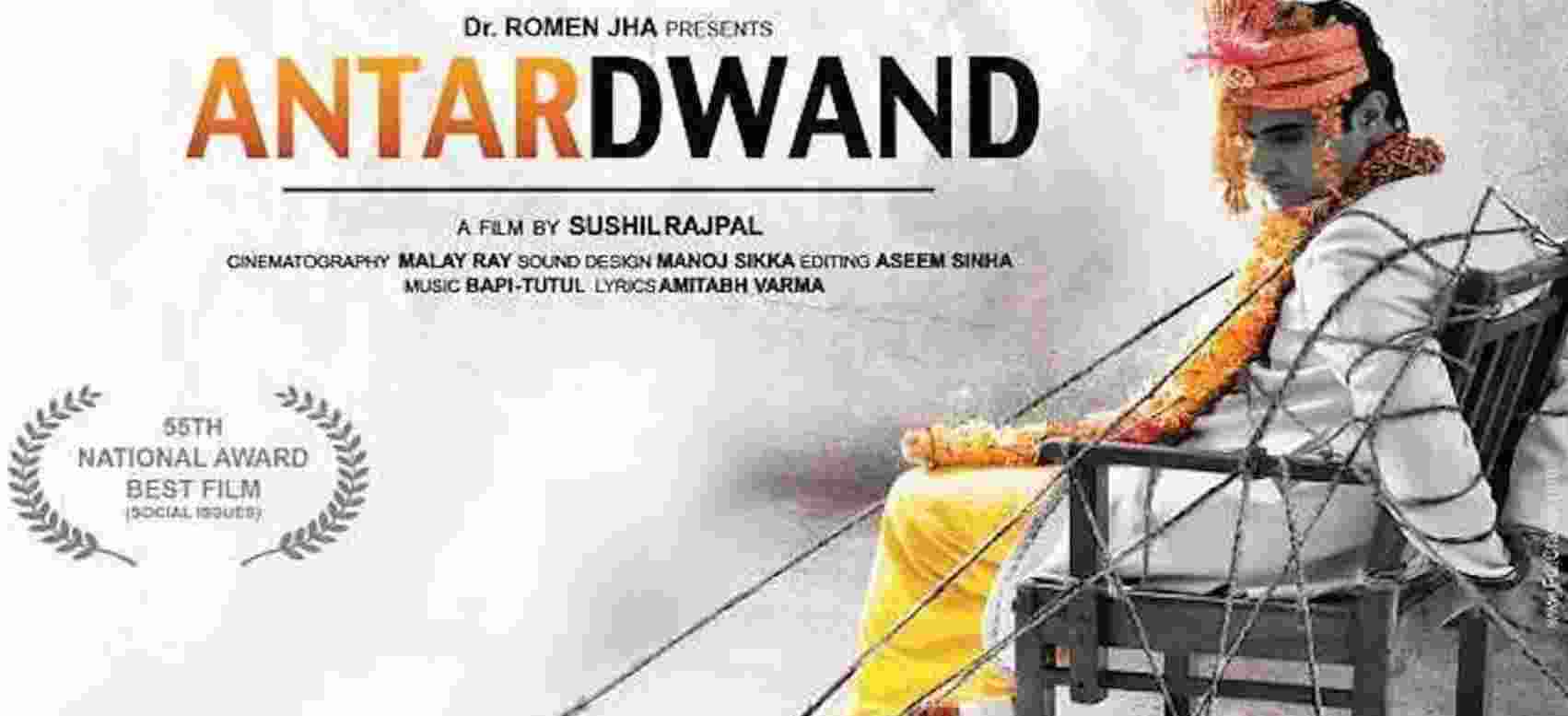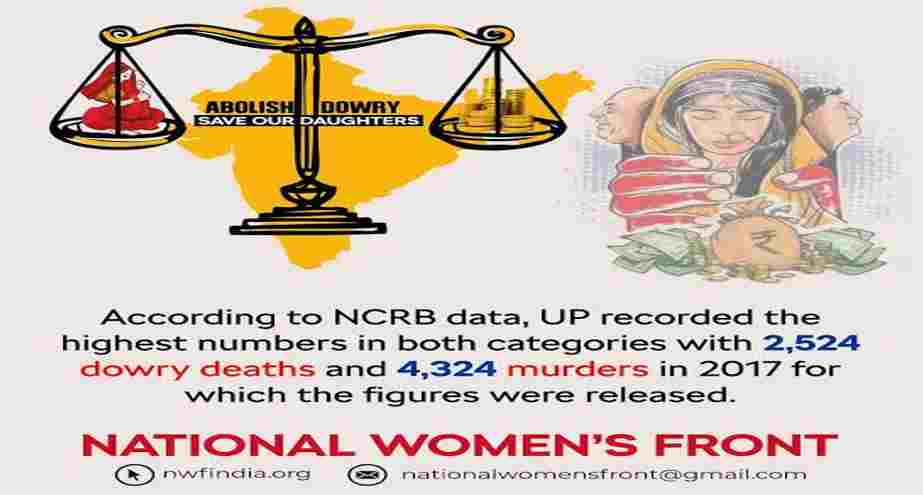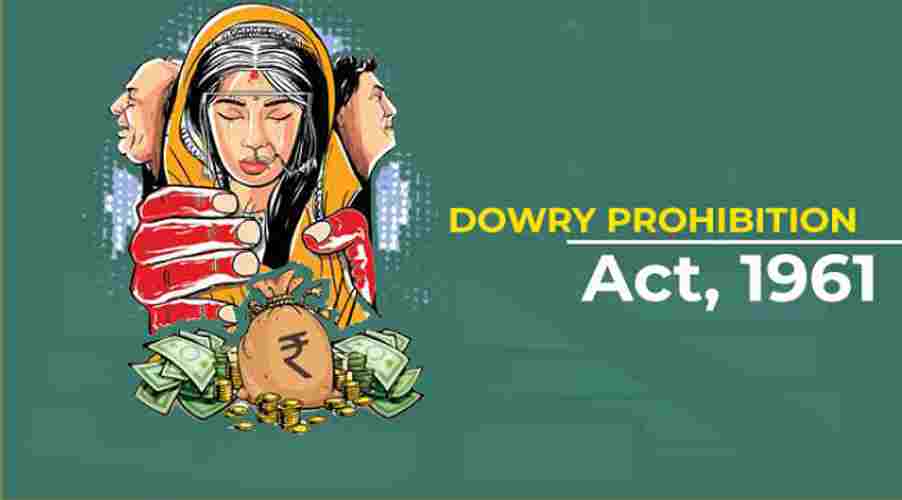
“Any young man, who makes dowry a condition to marriage, discredits his education and his country and dishonors womanhood.”
– Mahatma Gandhi
Introduction
- Dowry or dahej as it is called in Hindi is defined as the money, goods, or estate given from the bride’s side to the groom and his family upon marriage. In the far eastern parts of India, dowry is called Aaunnpot. It may include cash, jewelry, electrical appliances, furniture, crockery, utensils, car, and other household items that help the newly married couple to start their life journey. The dowry is an ancient tradition found across different religions, cultures, countries, and time periods. Dowry is accepted in many parts of the world and is sometimes used as a condition of the contract that if not accepted then the wedlock came to an end, particularly in parts of Asia and North Africa. Dowry is a menace and a harsh reality of the present society. Dowry deaths are one of the worst types of violence against women prevailing in society. Dowry’s death is violence by the husband and his family with a motive of extortion of gifts and other demands from time to time against a woman. A woman leaves their house and trusts her husband and his family to leave a dignified life, but the reality is totally different the greedy husband and his relatives in turn cause dowry death, which is unpardonable.
Historical Background

In India, the dowry system puts a great financial burden on the bride’s family. Dowry has become the foundation on which explanations for discrimination against women have been conveniently built because it has had the conceptual richness to satisfy a variety of analytical causes since the mid-19th century. British colonialists stressed its cultural roots in a benighted in Hinduism with its rigid caste system, Marxists see it as a retrograde economic institution; the feminists see gender discrimination in it because women are given dowries but not a share in the family property.
The system of Dowry existed in India even before the British Rule, but not in the format that is prevalent in society today. In the pre-colonial period, dowry was an institution managed by women, for women, to enable them to establish their status and have recourse in an emergency. So, in the original system of dowry prevalent in India, women were gifted wealth from their parents during marriage and this served as a tool of financial independence for the bride even after marriage. Even during the initial days of the British rule, contemporary European writers Orme, the French Catholic missionary Jean-Antoine Dubois who came to India in 1792, praised the status of Hindu women in India.
During medieval times, dowry was treated as a gift in cash or kind given to a bride by her family to maintain her independence after marriage. During the colonial period, it became the only legal way to get married, with the British making the practice of dowry mandatory and this created the menace of the dowry system in India. Because of the massive economic and societal changes brought on by British rule, women’s entitlements to the precious resources obtained from the land were erased and their control of the system diminished, women were prohibited from owning any property at all, this ultimately resulting in a devaluing of their very lives. The trend in present India, with its booming economy, is now encouraging ever-higher bride prices among all socioeconomic strata.
Reasons For The Existence Of The Dowry System In India
Traditions and Customs: – The structure of marriage contributes to dowry. In addition to marriage customs that influence dowry, social customs or rituals, and parents’ expectations of dowry are important factors to consider. Most dowry-related cases in India take place to adhere to the customs and traditions of Indian society.
Illiteracy: – It is the major problem of our nation and is the penultimate factor behind the problem of dowry. Lack of education and awareness among people persuades them to give and demand dowry. In underdeveloped areas, where the literacy rate is quite low and people are unaware of the laws relating to dowry, contributes to dowry-related cases. Although dowry is also practiced by the literates of our society, it becomes a lot difficult to make them understand the laws.
Societal Pressure and Reputation: – In Indian society, it has become a common phenomenon to measure one’s status by the amount of money one spends on their daughter’s marriage. Similarly, in the more educated and well-to-do family, the groom belongs, and the amount of dowry is high. It is a belief among people that dowry giving or receiving gives a lot of merit in reputation within the society. The pressure thus increases on both fronts, on the bride’s side to pay more, and on the groom’s side to demand more. In the 21st century, this is the most plausible reason for the existence of stealth-like dowry.
Social Structure: – Many a time, it becomes a matter of status to give dowry. Similarly, in the more educated and well-to-do family, the groom belongs, and the amount of dowry is that high. The pressure thus increases on both fronts, on the bride’s side to pay more, on the groom’s side to demand more.
Religious Factor: – The dowry system is not religion specific. It is present among different religions in different forms. For example, Indian Muslims call dowry jahez, and justify the practice in terms of jahez-e-fatimi.
Types Of Dowry Crimes

- Dowry death, murder-suicide, cruelty, domestic violence, and bride burning are social problems present in our society and these evils frequently translate into physical, mental, or sexual violence against the bride. The violence includes burning the woman alive by pouring kerosene on her.
Domestic Violence: – It can be defined as a pattern of behavior in any relationship that is used to gain or maintain power and control over an intimate partner.
Suicide: – The dowry crime also includes all acts and attempts to intentionally advise, encourage, or assist in committing suicide. Continuing abuse by the husband and his family with threats of harm could lead to a woman committing suicide.
Cruelty: – Cruelty in the form of torture or harassment of a woman with the objective of forcing her to meet a demand for property or valuable security is a form of dowry crime. In many instances, the cruelty may even force the woman to commit suicide and it has been specifically criminalized by the anti-dowry laws in India.
Dowry death: – Dowry deaths relate to a bride’s suicide or killing committed by her husband and his family because of their dissatisfaction with the dowry.
Famous Book On Dowry System By Veena Talwar

- “Dowry Murder: The Imperial Origins of a Cultural Crime” is a well-researched book by Veena Talwar Oldenburg that tries to trace the origin of the dowry system in India. In this book, the author follows the paper trail left by British bureaucrats during the British colonial rule of India.
Veena Talwar Oldenburg argues that these women killings are neither about dowry nor reflective of Indian culture or caste system that encourages violence against women. Rather, such killings can be traced directly to the influences of the British colony. The author also looks at the contemporary violence against wives and daughters-in-law in modern India.
Movies On Dowry System
1. Dahej (1952)
Dahej is a family drama based on the dowry system directed by V. Shantaram. The film starred Prithviraj Kapoor, Karan Dewan, Jayshree, Ulhas, Mumtaz Begum, Keshavrao Date, and Lalita Pawar. This movie revolves around the basic idea of dowry found in many Indian families. The boy meets the girl, the boy falls in love with a girl (and vice-versa), the topic of marriage is broached, a dowry is demanded, and various complications arise resulting in the “ultimate sacrifice” with her death.

2. Prem Rog (1982)
- Prem Rog is a Hindi movie directed by Raj Kapoor which focuses on a widow’s pathetic conditions and remarriage. In Prem Rog, Raj Kapoor raises his voice against caste discrimination and supports widow remarriage. This 1982 treatise on the ghastly caste divide in India and the horrible state of widows is packaged as a sensitive love story between an upper-caste widow and a young man of lowly status.

3. Antardwand (2009)

Antardwand won the National Film Award for Best Film on social issues at the 2009 National Awards. The film was based on groom kidnappings that took place in Bihar in the last decade. Eligible bachelors are abducted by a bride’s family and forcefully married so that they can avoid paying high dowry to the groom’s family. Groom kidnapping cases registered a surge after a period that marked the exponential rise in cases of women being mistreated by their in-laws because of their ever-growing hunger for monetary gifts from the bride’s family in the form of dowry, which is shockingly carried on currently.
Dowry Death Statistics In India

A study of over 40,000 marriages between 1961 and 2008 showed dowry was paid in 95% of them.
India has the highest number of dowry-related deaths in the world according to Indian National Crime Record Bureau.
Year | No. of cases reported |
2010 | 8391 |
2011 | 8618 |
2012 | 8233 |
2013 | 8083 |
2014 | 8455 |
2015 | 7634 |
2016 | 7621 |
2017 | 7466 |
2018 | 7167 |
2019 | 7141 |
2020 | 6966 |
- In 2020, the number of cases has gradually declined as compared to 2014, in which the number of cases was approx to 8.5 thousand. In 2020, Uttar Pradesh had the highest number of reported dowry deaths with more than two thousand cases registered. The average net dowry has been stable over time with some inflation before 1975 and after 2000.
Dowry Laws In India
- The lawmakers, in accordance with the seriousness and consequence of the dowry problem, aim at making legislative measures to plug the loopholes in the law as well as to enact new provisions to make the law rational and effective. Several acts, amendments, and steps have been taken by the government to deal with dowry-related crimes.
1. Dowry Prohibition Act:-

- The Dowry Prohibition Act is the first national legislation to deal with the social evil of dowry which was passed in 1961. The act aims to prohibit the giving and taking of dowry. The Act defines dowry as any property or valuable security given or agreed to be given directly or indirectly by one party to the other, or by the parents of either party or by any other persons to either party. Dowry does not include dower or mahr (gifts given by the bridegroom to the bride at the time of marriage), in the case of persons to whom Muslim Personal Laws apply.
2. Relevant Sections Under Dowry Prohibition Act:-
Section 2 of the Dowry Prohibition Act, 1961 states that any security that is valuable or any property transferred from one to another directly or indirectly in relation to marriage will be considered a dowry.
Section 3 of the Dowry Prohibition Act, 1961 describes the punishment for giving and taking dowry, which is a minimum five-year term and a fine of either Rs 15,000 or the value of the dowry.
Section 8 of the Dowry Prohibition Act, 1961 makes the punishment of section 3 and Section 4 harsher, as it makes the offense non-bailable and cognizable.
3. Indian Penal Code:-
The Indian Penal Code, 1980 intends not only to prohibit the dowry system in India but to prohibit the violence related to it. The menace of dowry has been covered in three sections of the Indian Penal Code Viz. Section 304-B, Section 406, Section 498-A.
Section 302 = The judiciary includes a murder charge under Section 302 IPC as this allows courts to impose the death penalty on perpetrators of the offense.
Section 406 = This section is usually applied in the investigation of Streedhan recovery from the husband and his family. Streedhan is what a woman can claim as her own property within a marital household.
- Section 498(A) = Husband or relative of husband of a woman subjecting her to cruelty. In this section, “cruelty” means:-
any conduct which is of such a nature as is likely to drive the woman to commit suicide or to cause grave injury or danger to limb or health of the woman; or if
harassment of the woman where harassment is with a view to coercing her or any person related to her to meet any unlawful demand for any property or valuable security or is on account of failure by her or any person related to her to meet such demand. Whoever, being the husband or the relative of the husband of a woman, subjects such woman to cruelty shall be punished with imprisonment for a term which may extend to three years and shall also be liable to a fine.
4. Indian Evidence Act:-
- Section Indian Evidence Act, 1872 was amended by adding 113(b) in it. It deals with the burden of proof on the offender if harassment or cruelty or both has been done in relation to dowry demand, and it should have been done soon before the death. It is noteworthy that death will fall under the dowry death category only if it has occurred within seven years of marriage.
5. Code Of Criminal Procedure:-
- As an outcome of the Sushil Kumar Sharma vs. Union of India (2005) case, the Code of Criminal Procedure, 1973 provides that for the prosecution of offences under Section 498A IPC, the courts can take cognizance only when it receives a report of the facts from the police or upon a complaint being made by the victim or her family. Under the amendment of 1983 in the Act, it is mandatory for the police to send the dead body for a post-mortem examination of the death has occurred within seven years of marriage and under any dubious circumstances.
Important Dowry Cases
1. Reema Aggarwal vs Anupam, 2004
- In Reema Aggarwal vs Anupam, the legality of dowry demand in respect of invalid marriage was dealt with.
Judgment:- In this, the session court held that the concept of dowry is linked with marriage and the provisions for dowry death apply to married persons only. The respondent married the appellant during the life of his surviving wife. Husband means a person who had entered into the relation of marriage and ordered flexible interpretation.
2. Rajinder Singh vs State of Punjab, 2015
- In this case, the court has explained the term “soon before death”.
Judgment:- The court, in this case, observed that what is necessary is that the demand for the dowry should be continuing cause for the death of the married woman, time delays might vary in cases. What must be borne in mind is that the word ‘soon’ does not mean ‘immediate’.
Rajesh Sharma and Ors. vs State of Uttar Pradesh, 2017
- The Court in this case gave further stringent criteria for the determination of the case under Section 498A.
- It mandates the setting up of a family welfare committee in every district for scrutinizing dowry harassment cases.
- The members of this committee shall be social workers or persons interested in the subject.
- The members shall be paid an honorarium.
- The police must investigate the recommendations of these committees before making any arrests.
The purpose of the provision to provide relief to the women facing harassment in their matrimonial homes including dowry deaths or cruelty has been overlooked.
Other important dowry cases are;
- Bachni Devi vs State of Haryana, 2011
- Nasruddin Mian vs State of Bihar
- Rajesh Sharma and Ors. vs State of Uttar Pradesh, 2017
Top 13 Interesting Facts About Dowry System
Dowry was first practiced in England by the Normans in the 12th century.
In India, people for the very starting practiced a dowry system during the medieval period when a gift in form of cash or kind was given to a bride by her family to maintain her independence after marriage.
The judgment of Rajesh Sharma and Ors. vs State of Uttar Pradesh, 2017 case has been the point of criticism from various feminist NGOs and women social activists. The judgments have been accused of promoting the patriarchal view of society, ignoring the sentiments of the victims. There are claims that no legislation has drawn in so many controversies in India’s history since independence like Section 498A.
The first step or act against dowry practice came in 1961 at all Indian levels called Dowry Prohibition Act.
Other terms for this dowry system may be “bride price” or “bride wealth.”
It is often believed that dowry is practiced only in south Asian countries but now many other cultures participate in the dowry system today including but not limited to Jewish, Slavic, Arab, East Asian, North-African, and Sub-Saharan African cultures.
The researchers found that the proportion of Indian marriages including dowry payments doubled between 1930 and 1975, and the average real value of dowry payments tripled. But post-1975, there was a decline in average dowry size.
India, Kerala has the highest dowry in India.
The earliest protests against dowry in the post-independence feminist movement were made by the Progressive Organization of Women in Hyderabad in 1975.
Satya Rani Chadha, a human rights activist is well known for launching the anti-dowry movement in India in the 1980s along with Shahjahan Apa.
Aleem khan, born in Hyderabad started his mission against dowry by creating awareness among the Muslims from India, Pakistan, and Bangladesh living in Saudi Arabia by holding functions and seminars.
Goa and Himachal Pradesh record the lowest dowry in India.
Dowry is a common practice in many parts of the world, especially in South Asia and several the Middle East and North African countries.






